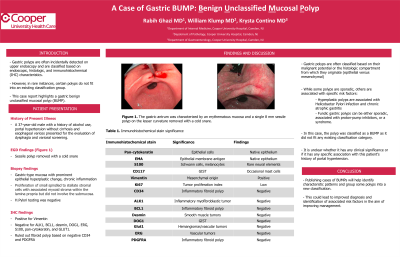Tuesday Poster Session
Category: General Endoscopy
P3428 - Unclassified: A Case of Gastric Benign Unclassified Mucosal Polyp
Tuesday, October 24, 2023
10:30 AM - 4:00 PM PT
Location: Exhibit Hall


Rabih Ghazi, MD
Cooper University Hospital at Cooper Medical School at Rowan University
Philadelphia, Pennsylvania
Presenting Author(s)
Rabih Ghazi, MD1, William Klump, MD2, Krysta Contino, MD3
1Cooper University Hospital at Cooper Medical School at Rowan University, Philadelphia, PA; 2Cooper University Hospital, Camden, NJ; 3Cooper University Hospital, Cooper Medical School at Rowan University, Camden, NJ
Introduction: Gastric polyps are often detected incidentally on upper endoscopy (EGD), and are classified based on endoscopic, histologic, and immunohistochemical (IHC) characteristics; however, in rare instances, certain polyps do not fit into an existing classification group. This case report highlights a gastric benign unclassified mucosal polyp (BUMP).
Case Description/Methods: A 37-year-old male with a history of alcohol use, portal hypertension without cirrhosis and esophageal varices presented for the evaluation of dysphagia and variceal screening. EGD showed grade II esophageal varices that were banded. The gastric antrum was characterized by an erythematous mucosa and a single 8 mm sessile polyp on the lesser curvature removed with a cold snare. Additional tissue was sampled at the scar site on follow up EGD. The initial biopsy showed gastric-type mucosa with prominent epithelial hyperplastic change, chronic inflammation, and proliferation of small, spindled to stellate stromal cells with associated myxoid stroma within the lamina propria but did not involve the submucosa. IHC stains were positive for Vimentin and negative for ALK1, BCL1, desmin, DOG1, ERG, S100, pan-cytokeratin, and GLUT1. Inflammatory fibroid polyp was ruled out based on negative CD34 and PDGFRA. Helicobacter Pylori testing was negative. The polyp was classified as a BUMP as it did not fit existing classification categories.
Discussion: Gastric polyps are often classified based on their malignant potential or the histologic compartment from which they originate (epithelial versus mesenchymal). While some polyps are sporadic, others are associated with specific risk factors. For instance, hyperplastic polyps are associated with Helicobacter Pylori infection and chronic atrophic gastritis, whereas fundic gastric polyps can be either sporadic, associated with proton-pump inhibitors, or a manifestation of a clinical syndrome. In this case, the polyp was classified as a BUMP as it did not fit any existing classification category. It is unclear whether it has any clinical significance or if it has any specific association with this patient’s history of portal hypertension. To our knowledge, these polyps have rarely been described in the literature. Publishing cases of BUMPs will help identify similar characteristics patterns and group some polyps into a new classification. This could lead to improved diagnosis and identification of associated risk factors in the aim of improving management.
Disclosures:
Rabih Ghazi, MD1, William Klump, MD2, Krysta Contino, MD3. P3428 - Unclassified: A Case of Gastric Benign Unclassified Mucosal Polyp, ACG 2023 Annual Scientific Meeting Abstracts. Vancouver, BC, Canada: American College of Gastroenterology.
1Cooper University Hospital at Cooper Medical School at Rowan University, Philadelphia, PA; 2Cooper University Hospital, Camden, NJ; 3Cooper University Hospital, Cooper Medical School at Rowan University, Camden, NJ
Introduction: Gastric polyps are often detected incidentally on upper endoscopy (EGD), and are classified based on endoscopic, histologic, and immunohistochemical (IHC) characteristics; however, in rare instances, certain polyps do not fit into an existing classification group. This case report highlights a gastric benign unclassified mucosal polyp (BUMP).
Case Description/Methods: A 37-year-old male with a history of alcohol use, portal hypertension without cirrhosis and esophageal varices presented for the evaluation of dysphagia and variceal screening. EGD showed grade II esophageal varices that were banded. The gastric antrum was characterized by an erythematous mucosa and a single 8 mm sessile polyp on the lesser curvature removed with a cold snare. Additional tissue was sampled at the scar site on follow up EGD. The initial biopsy showed gastric-type mucosa with prominent epithelial hyperplastic change, chronic inflammation, and proliferation of small, spindled to stellate stromal cells with associated myxoid stroma within the lamina propria but did not involve the submucosa. IHC stains were positive for Vimentin and negative for ALK1, BCL1, desmin, DOG1, ERG, S100, pan-cytokeratin, and GLUT1. Inflammatory fibroid polyp was ruled out based on negative CD34 and PDGFRA. Helicobacter Pylori testing was negative. The polyp was classified as a BUMP as it did not fit existing classification categories.
Discussion: Gastric polyps are often classified based on their malignant potential or the histologic compartment from which they originate (epithelial versus mesenchymal). While some polyps are sporadic, others are associated with specific risk factors. For instance, hyperplastic polyps are associated with Helicobacter Pylori infection and chronic atrophic gastritis, whereas fundic gastric polyps can be either sporadic, associated with proton-pump inhibitors, or a manifestation of a clinical syndrome. In this case, the polyp was classified as a BUMP as it did not fit any existing classification category. It is unclear whether it has any clinical significance or if it has any specific association with this patient’s history of portal hypertension. To our knowledge, these polyps have rarely been described in the literature. Publishing cases of BUMPs will help identify similar characteristics patterns and group some polyps into a new classification. This could lead to improved diagnosis and identification of associated risk factors in the aim of improving management.
Disclosures:
Rabih Ghazi indicated no relevant financial relationships.
William Klump indicated no relevant financial relationships.
Krysta Contino indicated no relevant financial relationships.
Rabih Ghazi, MD1, William Klump, MD2, Krysta Contino, MD3. P3428 - Unclassified: A Case of Gastric Benign Unclassified Mucosal Polyp, ACG 2023 Annual Scientific Meeting Abstracts. Vancouver, BC, Canada: American College of Gastroenterology.
